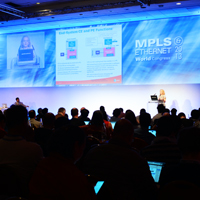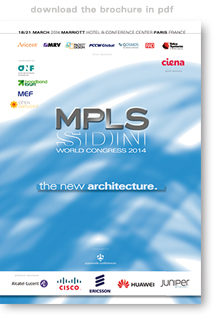| |
|
|
|
| |
|
THURSDAY 20 MARCH 2014 | CONFERENCE DAY TWO |
|
| |
|
|
|
| |
|
|
|


 




|
|
07.45 |
WELCOME, REGISTRATION AND COFFEE |
|
| |
|
 |
MORNING CHAIRMAN
Azhar Sayeed | CISCO |
|
| |
|
|
| |
|
| |
Opening Session |
| |
|
| |
|
|
| |
08.30 |
 |
When all the Pieces Come Together
Andrew G. Malis | HUAWEI |
|
| |
|
|
| |
|
|
| |
08.50 |
 |
Dr. Yakov Rekhter | JUNIPER NETWORKS |
|
| |
|
|
| |
|
|
| |
Use Cases Session |
| |
|
| |
|
|
| |
09.30 |
Service Provider SDN: Lessons Learnt and Evolution |
|
| |
|
 |
Showing the results of customer lab-trials, and explaining how these fit into a Service Provider SDN vision. SDN Service Chaining is one of the key identified applications, which uses OpenFlow switching to dynamically chain network appliances like DPI, Firewall, VirusScan etc., in a much more effective way than with today's IP networks.
Elisa Bellagamba | Ericsson |
|
|
| |
|
|
|
| |
09.50 |
SDN based Network Architectures for Service Providers
Benefits and Challenges |
|
| |
|
 |
Providing a detailed view about the potential and challenges of SDN in combination with network virtualization from a services provider’s point of view. “Real world” use cases based on the existing requirements and network architecture are provided, including scenarios for virtualization of network functionalities (e.g. firewalling, warding against DDoS attacks, (virtual) ePC).
Nicolai Leymann
| Fixed Mobile Engineering | Deutsche Telekom AG |
|
|
| |
|
|
|
| |
10.10 |
SDN and Mobile Networks |
|
| |
|
 |
Flexibility and nimbleness is an absolute must to allow users to freely move between macro and fixed networks. SDN can provide dynamic policy and reconfiguration for this to happen.
Covering the role of SDN in the Mobile Networks both in EPC and the backhaul and discussing in depth the mobile use case and how SDN and virtualization can play a role for Mobile providers.
Azhar Sayeed | CISCO |
|
|
| |
|
|
|
| |
10.30 |
Carrier SDN with a Hybrid Control Plane: Use Cases and Proof Points |
|
| |
|
Demonstrating, with real-world uses cases, how Carrier SDN can be employed to extend infrastructure intelligence further towards the network edge and ultimately into the customer premise, leveraging cost-effective implementations of MPLS or non-MPLS devices in new reference architectures to reduce port counts and throughput demands on existing LSRs and LERs.
Christopher Liljenstolpe | Director of Solutions Architecture | Metaswitch |
|
| |
|
|
|
| |
10.50 |
COFFEE BREAK |
| |
|
|
|
| |
Mobile Backhaul Session |
| |
|
| |
|
| |
11.20 |
Wireless Meshed Networking for Small Cells Backhauling |
|
| |
|
 |
Small cells are increasingly gaining popularity among operators because they represent a sort of “ultimate” answer to the need of ubiquitous coverage and capacity.
Paolo Volpato | Product Strategy Manager | Alcatel Lucent |
|
|
| |
|
|
|
| |
11.40 |
 |
SDN-based Hybrid Access
Discussing problem statement: what is SDN-based Hybrid Access and its value proposition?
Presenting case studies.
Dr. XiPeng Xiao | Huawei Technologies |
|
|
| |
|
|
|
| |
12.00 |
SDN Impact on Mobile Broadband Networks |
|
| |
|
 |
Discussing the ways in which the SDN concept and its architecture principles can complement cloud and Network Function Virtualization in mobile broadband networks and advance the transformation of the network architecture into a pure software infrastructure which is highly efficient and flexible.
Nurit Sprecher | Nokia Solutions and Networks |
|
|
| |
|
|
|
| |
12.30 |
LUNCH |
|
| |
|
|
|
| |
|
 |
AFTERNOON CHAIRMAN
Jean-Marc Uzé | Juniper Networks |
|
| |
|
|
|
| |
|
|
|
| |
MPLS, SDN & NFV for Enterprises Session |
| |
|
| |
|
|
|
| |
14.00 |
Extending The Geographic Reach of a VPN Service |
|
| |
|
 |
Describing the concept of VSDP and how it can be implemented based on Inter-provider Option B. It describes how VSDPs can be used to provide a seamless VPN service across geographic regions. Potential deployment options, secure deployment procedures as well as the trust models will be discussed in detail.
Ron Bonica | Distinguished Engineer | Juniper NETWORKS |
|
|
| |
|
|
|
| |
14.20 |
Beyond the Data Centre: SDN & NFV in the Customer Premises |
|
| |
|
 |
How CSPs need adapt their engagement with the enterprise if they are to realise a shared vision for SDN & NFV.
How the programmable delivery of new services to the enterprise will enable CSPs to measurably reduce a major component of network TCO: that of introducing a new service.
How network-edge and CPE routing technologies have evolved to become ‘SDN/NFV ready’.
Pravin Mirchandani | CMO | OneAccess |
|
|
| |
|
|
|
| |
|
|
|
| |
Segment Routing Session |
| |
|
| |
|
|
|
| |
14.40 |
 |
From Tag Switching to SDN and Segment Routing
MPLS: an Enduring Architecture
Covering the founding principles of MPLS that have allowed MPLS to evolve and morph in so many ways. Exploring how separation of control and data, PCE, BGP-LS have combined to enable SDN control of MPLS via Segment Routing.
George Swallow | Cisco |
|
|
| |
|
|
|
| |
15.00 |
Segment Routing: Update and Future Evolution |
|
| |
|
 |
By 2014, the first phase of the Segment Routing will be available. Providing an update on the product, the standardization process and most specifically focusing on the deployment use-cases it supports.
Introducing the future evolution of the technology and new use-cases that we want to support.
Clarence Filsfils | Cisco |
|
|
| |
|
|
|
| |
15.20 |
Fast Reroute Approach Using Segment Routing |
|
| |
|
Fast ReRoute protection is needed to complement network convergence when traffic restoration time requirements are high.
Several fast reroute solutions already exists for IP or MPLS networks but none is meeting all the operator’s expectations (coverage, simplicity, side effects …).
Detailing a new Fast Reroute approach using the flexibility of Segment Routing technology. Comparing it with existing Fast ReRoute solutions, both from a theoretical point of view and with simulations results on a real SP network topology.
Stephane Litkowski | Orange |
|
| |
|
|
|
| |
15.40 |
COFFEE BREAK |
|
| |
|
|
|
| |
16.10 |
 |
MPLS Label Advertisement in IGPs
Highlighting historical approaches to link-state routing using the notion of short, fixed size 'labels' and comparing them to the recent MPLS incarnations, particularly "Segment routing" and "IGP Label Advertisement".
Hannes Gredler | Distinguished Engineer |
Juniper Networks Inc. |
|
|
| |
|
|
|
| |
16.30 |
Segment Routing in Seamless MPLS Networks |
|
| |
|
SR as an alternative to LDP protocol to reduce the number of control planes in the domain.
SR used together with LDP to enhance the coverage of IP and LDP Fast-Reroute (FRR)
SR use to provide source routed paths to applications in domains of the network where the operator does not want or cannot operationalise the RSVP-TE protoctol.
Mustapha Aissaoui | Product Line Manager, IP Division | Alcatel-Lucent |
|
| |
|
|
|
| |
16.50 |
RSVP-TE for ECMP, traffic Engineering & Segment Routing |
|
| |
|
Segment Routing is emerging as an interesting mechanism to offer simplicity, scale and support for a wide array of applications. Discussing a use case for SR providing an insight into how and under what circumstances - carriers can deploy both these vehicles in enhancing network functionality and reducing operational complexity.
Vinod Joseph | Principal Architect for Advanced Technology Solutions |
Juniper Networks |
|
| |
|
|
|
| |
17.10 |
Source Label - MPLS Improvement |
|
| |
|
Why do we need MPLS Source Label
The concept of MPLS Source Label
The Data Plane processing
Source Label signaling (Capability negotiation and Source Label distribution)
Use cases of MPLS Source Label.
Mach Chen | Senior Staff Engineer, Carrier IP Product Line |
Huawei Technologies |
|
| |
|
|
|
| |
17.30 |
END OF THE CONFERENCE DAY TWO |
|
| |
|
|
|
|
| |
|
|
|
|